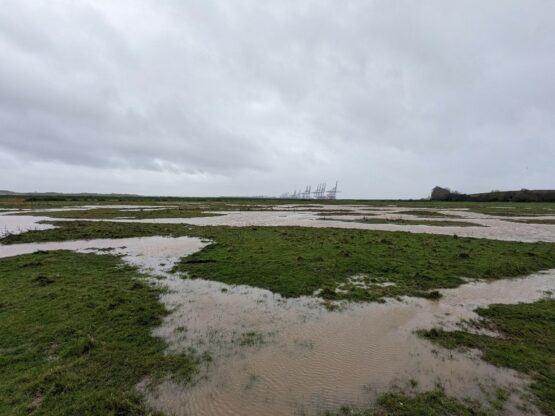Farming in Protected Landscapes Case Study:
Trimley Marshes wetland improvement project

In 2023-24, the Suffolk & Essex Coast & Heaths National Landscapes granted £17,581 to farmers R&H Wrinch for wetland improvements at the Orwell Estuary, which is a SSSI site.
From the site, you can see Felixstowe docks across the river Orwell. This work will benefit breeding wader birds such as sandpipers, curlew, lapwing, redshank and snipe.
Why was the work needed?
These grazing marshes were known for attracting breeding lapwing and redshank every year, which has sadly not been the case recently. Due to climate change, rainfall in April and May has reduced considerably, leaving the muddy areas hard and dry.
Currently breeding wader birds are in decline throughout England and the Suffolk coastal area, due to a range of factors, but this lack of an easily accessible food supply for foraging chicks has been reducing the success of the chicks growing and fledging.
What did this project involve?
Working with the RSPB, the landowner arranged for the installation of two water control structures which will help to hold water levels high enough to fill nearly 5000m² of new footdrains, and the creation of a ditch 40m long which will allow water to flow from a newly created reservoir then into existing ditches.
The existing ditches were restored to a length of 366m, to give a clear path for the movement of water, as they were previously choked with vegetation. An existing creek has been reprofiled to make it more suitable for foraging chicks, which previously could not forage there, due to the steepness of the creek edges. As water flows in and out of the creek it will create areas of mud suitable for the birds to forage for invertebrates.
How will the birds benefit?
Both lapwing and redshank, listed as Red and Amber status respectively on the BTO’s Birds of Conservation Concern 5, in 2021, continue to decline. This is mainly due to the
limited availability of crucial protein rich-invertebrate food for foraging chicks later in the breeding season, once the grass sward becomes too tall for them to forage effectively.
This important food source is concentrated in wet mud, which is revealed as the water level recedes in linear foot-drains. A combination of easily accessible and abundant food source helps chicks forage effectively, growing stronger and healthier quicker, in turn, making them more alert when danger approaches.
This project will deliver an abundance of invertebrate food for foraging chicks at a time when it is needed most, which is currently lacking on these marshes, through the lack of water and of a water level being high enough to fill foot-drains.
As the water is allowed to recede, through manipulation of the installed water control structures, it will produce large quantities of wet mud along the edges of the newly created foot-drains, creating a huge abundance of easily accessible food in the wet mud for foraging chicks and increasing fledgling success. In addition, adult lapwing and redshank are attracted to areas which have foot-drains holding water early in the breeding season, indicating the importance of water on grazing marshes.
What will happen next?
The landowner will use this project to show case to other likeminded farmers and landowners, college and university students studying agriculture and countryside management to show how farming can help conservation become successful.
